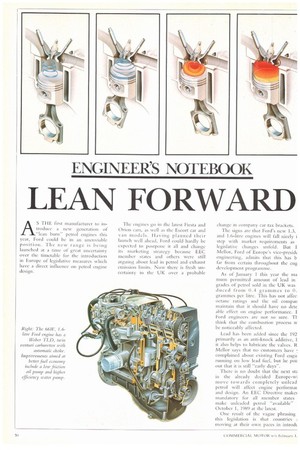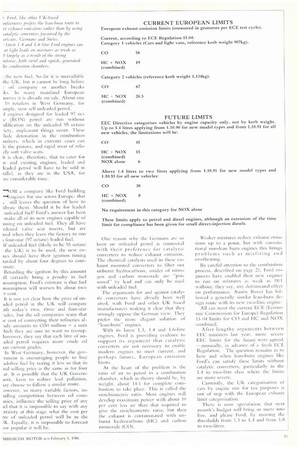LEAN FORWARD
Page 50

Page 51

If you've noticed an error in this article please click here to report it so we can fix it.
As.FHE first manufacturer to introduce a new generation of "lean burn" petrol engines this year, Ford could be in an unenviable position. The new range is being launched at a time of great uncertainty over the timetable for the introduction in Europe of legislative measures which have a direct influence on petrol engine design.
The engines go in the latest Fiesta and Orion cars, as well as the Escort car and van models. !Living planned their launch well ahead, Ford could hardly be expected to postpone it all and change its marketing strategy because EEC member states and others were still arguing about lead in petrol and exhaust emission limits. Now there is fresh uncertainty in the UK over a probable change in company car tax brackets.
The signs are that Ford's new 1.3, and 1.6-litre engines will fall nicely i step with market requirements as legislative changes unfold. But 1 Mellor, Ford of Europe's vice-preside engineering, admits that this has b far from certain throughout the eng development progranune.
As of January 1 this year the ma mum permitted amount of lead in grades of petrol sold in the UK was duced from 0.4 grammes to 0. grammes per litre. This has not affec octane ratings and the oil compan maintain that it should have no dete able effect on engine performance. 1 Ford engineers are not so sure. TL think that the combustion process IT be noticeably affected.
Lead has been added since the 192' primarily as an anti-knock additive, E it also helps to lubricate the valves. R Mellor says that no customers have , complained about existing Ford etigh running on low lead fuel, but he poi' out that it is still "early days".
There is no doubt that the next sta in the already decided Europe-wi move towards completely unlead petrol will affect engine performai and design. An EEC Directive makes mandatory for all member states make unleaded petrol "available" October 1, 1989 at the latest.
One result of the vague phrasing this legislation is that countries ; moving at their own paces in intro& the new fuel. So for it is unavailable the UK, but it cannot be long before oil company or another breaks In inany mainland European unties it is already on sale. About one 10 retailers in West Germany, for imple, now sell unleaded petrol.
if engines designed for leaded 97 ocLe (RON) petrol are run without idification on the unleaded 95 octane -iety, unpleasant things occur. These lude detonation in the combustion unbers, which in extreme cases can le the pistons, and rapid wear of relaely soft valve seats.
It is clear, therefore, that to cater for w and existing engines, leaded and leaded petrol will have to be sold in ralk:I, as they are in the USA, for me considerable time.
OR a company like Ford building engines for use across Europe, that . still leaves the question of how to Vibrate them. Should it be for leaded unleaded fuel? Ford's answer has been make all of its new engines capable of nning on unleaded fuel. They all have rdened valve seat inserts, but are tied when they leave the factory to run four-star (97 octane) leaded fuel.
If unleaded fuel (likely to be 95 octane the UK) is to be used, the new ennes should have their ignition timing tarded by about four degrees to com-nsate.
Retarding the ignition by this amount ill certainly bring a penalty in fuel nistimption. Ford's estimate is that fuel insuniption will worsen by about two
cent.
It is not yet clear how the price of madded petrol in the UK will compare ith today's two, three and four-star 'ides. but the oil companies warn that le cost of converting their refineries al.ady amounts to ti550 million — a sum 'hich they are sure to want to recoup. toreover, they say that each litre of unaded petrol requires more crude oil Ian current grades.
In West Germany, however, the goyim/tent is encouraging people to buy .ad-free fuel by taxing it less so that its lial selling price is the same as for four :ar. It is possible that the UK Governlent, keen to reduce lead pollution, lay choose to follow a similar route. lowever. so many variable factors, inuding competition between oil commies, influence the selling price of any tel that it is impossible to say with any :rtainty at this stage what the cost per Ere of unleaded petrol will be in the 1K. Equally, it is impossible to forecast ow popular it will be. One reason %%Ay the Germans Are so keen on unleaded petrol is connected with their preference for catalytic converters to reduce exhaust emission. The chemical catalysts used in these exhaust mounted converters to filter out unburnt hydrocarbons, oxides of nitrogen and carbon monoxide are "poisoned" by lead and Call only be used with unleaded fuel.
The arguments for and against catalytic converters have already been well aired, with Ford and other UK based manufacturers making it clear that they strongly oppose the German view. They prefer the more elegant solution of "lean-hum" engines.
With its latest 1.3. 1.4 and 1.6-litre engines, Ford is providing evidence to support its argument that catalytic converters are not necessary to enable modern engines to meet current, and perhaps future, European emission limits.
At the heart of the problem is the ratio of air to petrol in a combustion chamber, which in theory should be, by weight, about 14:1 for complete combustion to take place. This is called the stoichiometric ratio. Most engines will 'develop maximum power with about 10 per cent less air than that required to give the stoichiometric ratio, hut then the exhaust is contaminated with umburnt hydrocarbons (1-1C) and carbon monoxide (CO).
Weaker mixtures reduce exhaust emissions up to a point, but with conven
tional non-lean burn engines this brings problems SLIC11 as misfiring and overheating.
By careful attention to the combustion process, described on page 21, Ford engineers have enabled their new engines to run on mixtures at. weak as 18:1 without, they say, any detrimental effect on performance. Austin Rover has tbllowed a generally similar lean-burn design route with its new two-litre engine.
All can meet the current ECE (Economic Cornmission for Europe) Regulation 15 04 limits for CO and HC and NOX combined.
After lengthy arguments between EEC ministers last year, more severe EEC limits for the future were agreed.
— unusually, in advance of a fresh ECE Regulation. The question remains as to how and when lean-burn engines like Ford's can satisfy these limits without catalytic converters, particularly in the 1.4 to two-litre class where the limits are more severe.
Currently. the UK categorisation of cars by engine size for tax purposes is out of step with the European exhaust limit categorisation.
There is now speculation that next month's budget will bring us more into line, and please Ford, by moving the thresholds from 1.3 to 1.4 and from 1.8 to two-litres.




















































